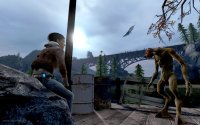Virgin Games’ A World of My Own is accepting beta tester applications. As well as early (but NDA-ed) access, “if you’re chosen from one of the first 30,000 players to register you’ll be rewarded with big discounts and special on going privileges”.
You’ll be asked for your street address during the signup process, but your form will be accepted with “prefer not to disclose” messages in the offending fields. Be warned though: dummy information may well harm your chances of being picked!
Valve have announced that the Half-Life 2 “black box” SKU will no longer be shipped, leaving PC players with either the orange box, which also contains Half-Life 2 and Episode One, or Steam, which is still set to offer a package of just the three new titles. (This may now only happen once the games have been released on 10 October.)
This is clearly a move designed to let Valve undercut retailers by organising the availability of a clutch of highly-anticipated games online and offline, as happened at Half-Life 2’s launch when Steam’s Silver package gave far better value for money than retail options.
In this case, Valve are circumventing retailer’s hold over minimum prices: stores can easily refuse to stock a product if it’s being sold for less online, but refusing to stock a different pack because a theoretically less valuable one is being sold cheaper elsewhere might not go down so well with shareholders.
The reverse effect of retailers undercutting Steam is also undoubtedly on Valve’s mind, as they lost a great deal of face when Episode One was sold on the high street and at e-tailers for less than its Steam price on day one. Will shops be willing or even able to cut prices enough to compete with a now unencumbered Steam? I doubt it. Unless you want HL2 or Episode One too, Episode Two’s package, I predict, is going to be cheap.
This will also be a marketing experiment for Valve: what proportion of their cornered market of Half-Life 2 and Episode One owners will they be able to convert into Episode Two buyers? It will be a measure of their confidence whether or not we see any advertising for the Steam package outside Update News items.
One of Valve’s earliest hopes for Steam was to use it to keep users’ display drivers up to date. Now, at long last, ATI have agreed to distribute their Catalyst drivers:
I’m pretty excited about finally getting some display drivers – the ATI announcement included that – where rather than having the situation they have right now where they literally tens, close to hundreds of display drivers out there on people’s machines, that everybody will have the most current, the most up-to-date driver, automatic bug-reporting and things like that. That’s a nice step forward.
As far as I’m aware the current Catalyst drivers don’t have a bug reporting system, meaning that the version that will be distributed over Steam has been integrated (or at least customised) to some extent. The download’s management, what with drivers being system tools that can’t realistically reside in SteamApps, may also break some new ground.
Looking at the hardware survey, there are tens of thousands of people playing with drivers over three years out of date! Many will have older hardware not supported by newer driver releases, but there are sure to be a fair chunk of gamers with old drivers holding back their performance and stability who will benefit from ATI’s decision.
Counter-Strike’s in-game adverts are the pilot for a Steam-wide system Valve intend to offer to independent developers, Gabe Newell has explained in an interview with GamesIndustry.biz:
We’re looking at a variety of ways of funding these development projects and it probably benefits us less than other kinds of developers. … I think where advertising-supported projects will be interesting is the degree to which it … [helps broaden] the distribution of games like Red Orchestra. I think that we’re going to start to see games that would struggle to get traditional publisher funding find that advertising is a great way of finding and developing an audience, and that’s why we’re putting the effort to make it possible for people to use Steam to do advertising-supported games.
Valve clearly aren’t too interested in running the adverts themselves, although quite why they waited so long to tell this to their very upset community is a question I’ll leave to them. We now know that:
- Adverts are unlikely to appear in other Valve games or in Steam itself, and
- Once the system is running smoothly they may be removed from Counter-Strike
Read the rest of this entry »
Valve’s forthcoming puzzle game Portal will feature a system for importing and loading fan-made maps, according to Eurogamer’s recent preview (paragraph three; annoying spoilers in one and two).
We should definitely expect user-created content, judging by the wealth of content that sprang from the free release of Portal’s progenitor, Narbacular Drop. “We have any easy-to-use way of getting maps into Portal and loading them up,” says Swift. “We’re definitely looking forward to seeing what people create. We’re going to be releasing our FGD and an SDK update so people can use what we’re using.” That should happen soon after Episode Two, Team Fortress 2 and Portal launch together [in October].
This doesn’t confirm that there will be a built-in library of third-party downloads, but given The Steam Community’s recent announcement and Valve’s ever-lurking peer-to-peer network, the odds are reasonable.
To read more about the distribution of community content, see Building communities through residency.
Well well well. 🙂
Back in 1996, two Microsoft executives quit their spectacularly high-paid jobs, formed a games company and made the best game ever. Twice.
They didn’t like the way retailers were throttling the industry’s creativity, so they cut them out. They did like what a lot of mod teams were doing, so they hired them. They published any game they liked through their digital distribution network, however commercially risky, and saved several independent developers in the process. Their revolution was so successful that today, major publishers like Eidos and Atari come to them to sell their games online. Now they’re gearing up to do it again, by turning Steam into a giant gaming community.
The teaser’s headlines:
- Free.
- “One-click matchmaking, both for new games and existing ones such as Counter-Strike. You’ll be able to jump straight into a game with players of your skill level, with no history of griefing, by pressing a single button.”
- A Halo 2-inspired party/clan system. “[Group] members can see when others are playing a game, join them, or schedule a match for a specific date and time. They’ll also have a dedicated chat channel to talk to each other on regardless of what game they’re playing, even between rounds.”
- “A personal gamer page that’s accessible via the web, with embarrassingly detailed stats about what you play, how much you play it, and what kind of player you are.”
Details are due at some point this week in PC Gamer UK, though whether they will be in the print or online edition first, or both at once, isn’t clear.
Turns out that the Steam interview won’t be published in print until 7 June — hopefully it’ll appear online before then!
It didn’t make the June 7th issue either. I will definitely have the details next month though, regardless of PCG! 🙂




